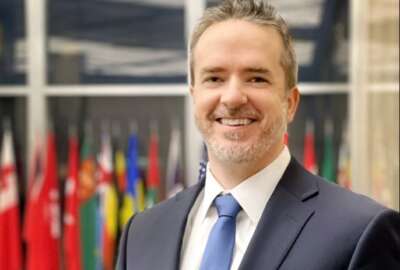Agencies already have the tools, interest for collecting LGBTQ data in decision making
The White House and members of Congress are calling for more collection of LGBTQ data by federal agencies. But this is something people have recommended doing for...
Bit by bit, federal government is taking steps to account for lesbian, gay, bisexual, transgender, queer and other sexual and gender minorities.
The Equal Employment Opportunity Commission is adding an X gender marker to voluntary questions for filing out a charge of discrimination, and it is adding an Mx gender marker to the Online Spanish Initial Consultation Form and Pre-Charge Inquiry Form.
The Air Force announced it would offer assistance to its families stationed in states with legislation criminalizing those who help transgender children take steps to affirm their gender, or laws banning official talk about sexual orientation in schools.
And last year, the Office of Personnel Management said widows and widowers of same-sex spouses could apply for or resubmit applications for federal survivor benefits if they were married before same-sex marriage was legalized by the Supreme Court. Legislation to extend these benefits was actually introduced in 2011, two years before the Supreme Court struck down the Defense of Marriage Act in United States V. Windsor — now in 2022, reading the arguments for delaying it to “preserve scarce government resources” is eyebrow raising, to say the least.
Now the White House and members of Congress are calling for more collection of LGBTQ data by federal agencies.
Last month the president issued an executive order for agencies to collect more sexual orientation and gender identity (SOGI) data, and the House Committee on Oversight and Reform voted in favor of requiring federal agencies to review where they can add SOGI questions to existing demographic surveys.
But this is something people have recommended doing for years. In fact, Debra Draper, director of Health Care Issues at the Government Accountability Office, talked about this two years ago on The Federal Drive with Tom Temin, specifically as it applies to the Department of Veterans Affairs. Without firm data from VA, rough estimates indicate about 1 million veterans identify as LGBTQ and that about 130,000 veterans are transgender, Draper said in 2020.
“They just need to consistently collect this information, and then we also recommended that they use this information to actually analyze the outcomes for this population,” Draper said. “For example, screening transgender men for breast and cervical cancer is important and required by VA policy but without the necessary data these services may not be provided.”
In 2011, the Institute of Medicine published a report on the overall state of science on sexual minority health. The report noted that “more research is needed on inequities in health care, and that such research depends on the collection of sexual orientation data in community, state, and national health surveys.”
Some have already started:
- The National Compensation Survey from the Bureau of Labor Statistics asks about same-sex domestic partnerships: at least since 2011.
- The National Health Interview Survey from the Centers for Disease Control and Prevention: since 2013.
- The National Crime Victimization Survey from the Bureau of Justice Statistics, and the National Survey of Drug Use and Health from the Substance Abuse and Mental Health Services Administration: since 2015.
And now the Census Bureau is collecting SOGI data in its experimental, rapid-response Household Pulse Survey on economic impacts of the COVID-19 pandemic, as of 2020.
So what’s the hold up for everyone else?
The National Science Foundation said in 2018 it would explore how to add SOGI questions to its workforce surveys, beginning with the 2021 National Survey of College Graduates. But observers were disappointed that the 2021 NSCG did not ask about sexual orientation and only used a modified gender question for a test sample, according to Science magazine. The Federation of American Societies for Experimental Biology recently urged NSF to expand that pilot effort to capture the full diversity of the federal scientific workforce.
It is true that agencies cannot just start surveying the public on anything they want, they have to comply with Office of Management and Budget regulations under the Paperwork Reduction Act of 1995. But the law has flexibilities to adapt to emerging technologies, as noted in a 2016 memorandum from the Office of Information and Regulatory Affairs. Large-scale public surveys need clearance, but that process can be fast-tracked such as for gathering customer service feedback.
“Generic clearance may be appropriate when (I) the need for the data collection can be evaluated in advance, as part of the review of the proposed plan, but (2) the agency cannot determine the details of the specific individual collections until a later time. Most generic clearances cover collections that are voluntary, low-burden, and uncontroversial,” then-OIRA Administrator Howard Shelanski wrote in the memo. “For example, generic clearances have proven useful for focus group testing and for preliminary versions of surveys shared with the public for the purposes of judging their clarity and usability.”
Shelanski also wrote that many eligible agencies were already using the fast-track process, including 100 different data collections at the Commerce Department “including numerous usability testing, website feedback, and customer satisfaction type information collections.”
Not following the OMB review process is risky, and justification for collecting public demographic data has to meet both OMB and constitutional thresholds. The Trump administration’s attempt to add a citizenship question to the 2020 census is one high-profile example. On Wednesday the House Committee on Oversight and Reform issued documents from its investigation, revealing that then-Commerce Secretary Wilbur Ross sought a loophole for the Census Bureau to add the question themselves after attempts to get the Justice and Homeland Security Departments to request the question failed. Ross claimed that sampling was insufficient to capture the number of non-citizens although the American Community Survey, which gathers data annually including on citizenship, does use sampling.
Advocates have been campaigning for decades to “Queer the Census” and add SOGI questions to the decennial count but it’s not clear if or when that would happen.
So again, “why aren’t agencies collecting this data more already?” I asked federal data experts and researchers over the past few weeks. They could not say for certain. But they did have a consensus on some things:
- The federal government currently has the ability, resources and expertise to do this. And interest in this data is wide-ranging across agencies.
- The data is important to achieve stated goals on equity.
- Our understanding of key social, economic and health indicators depends on having this data.
- Even though there’s no perfect way to collect this data, you have to start somewhere.
As stated at the top, these measures account for LGBTQ people, their presence, and their distinction from straight cisgender people. For a population that, historically and to this day, lived in hiding, denied their identities to family, friends and coworkers, being counted is imperative. State and local legislation has passed just within the last couple years for the expressed purpose of refusing to acknowledge the existence of LGBTQ people.
People are more than statistics, but numbers and records are how we move through this world, from passports and drivers licenses, to school transcripts, marriage licenses, resumes, W-2s, medical files, bills, credit scores, leases, titles and deeds, voter registrations, birth and death certificates. You can’t even blue-check verify yourself on Twitter, the site gets to decide if you are really you based on nebulous criteria.
Our world does not operate on oral history alone — we need documentation. We need data, and it needs to be accurate.
Nearly Useless Factoid
The Spanish national anthem, “Marcha Real,” has no lyrics.
Source: World Atlas
Copyright © 2025 Federal News Network. All rights reserved. This website is not intended for users located within the European Economic Area.
Amelia Brust is a digital editor at Federal News Network.
Follow @abrustWFED






